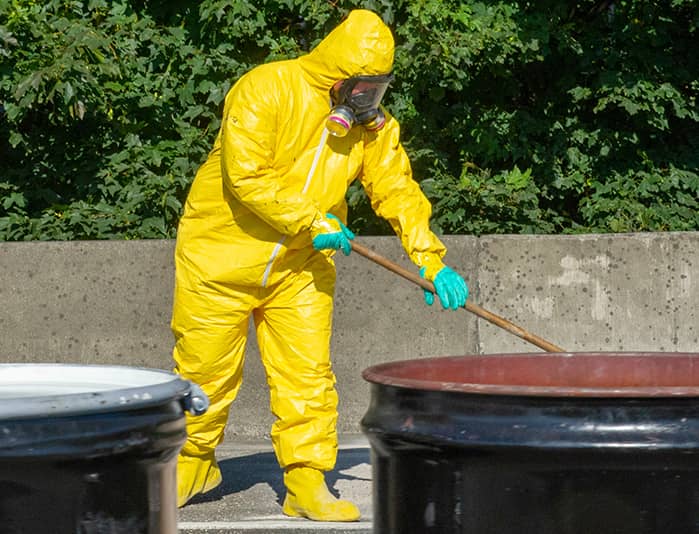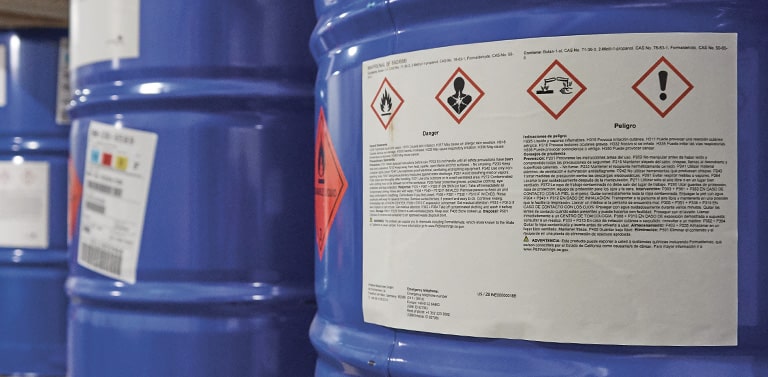These multi-course training curriculums cover the essentials of emergency response operations (HAZWOPER) at an awareness, operations, or hazmat technician level.
J. J. Keller Training offers HAZWOPER initial and refresher e-learning training courses and curriculums that incorporate interactive elements and images that reinforce each lesson.


HAZWOPER Hazardous Waste Site Cleanup Training
These multi-course Hazwoper training curriculums apply to employees working on sites with cleanup operations covered by the HAZWOPER standard and are exposed to hazardous substances, health hazards, or safety hazards.

HAZWOPER Emergency Response Refresher Training
These multi-course HAZWOPER refresher training curriculums cover the essentials of emergency response operations for awareness-level, operations-level, or hazmat technician level responders.
Start Your HAZWOPER Training Today!
- START TRAINING FOR FREE
Did you know?
Employers must supplement HAZWOPER online-based training.
In OSHA’s view, computer- or online-based training, by itself, is not sufficient to meet the intent of the agency’s training requirements for HAZWOPER, 29 CFR 1910.120 for general industry or 29 CFR 1926.65 for construction. Therefore, computer or online training, in the case of HAZWOPER, must be supplemented by site-specific elements, hands-on training and exercises, and an opportunity for trainees to ask questions of a qualified trainer. We recommend that employers who use computer- or online-based training as a tool to help with training under §1910.120 or §1926.65 also:
- Ensure the trainer is qualified, in accordance with §1910.120/§1926.65;
- Augment the online training with site-specific elements;
- Tailor the training to the employees’ assigned duties;
- Include hands-on training to familiarize trainees with equipment, personal protective equipment, and safe practices;
- Provide trainees with immediate and direct access to a qualified trainer as they are taking the course;
- Offer an opportunity for trainees to ask questions of the qualified trainer;
- Ensure all training elements listed in the regulation are covered;
- Meet the training duration requirement under §1910.120/§1926.65 (NOTE: If computer- or online-based training does not fill the training duration requirement, it is anticipated the remaining duration will be filled with the items in the suggested bullet items above);
- Ensure a trained, experienced supervisor provides any required days of actual field experience for trainees under his or her direct supervision; and
- Ensure the trainer (or head instructor), trained supervisor, and, according to OSHA sources, the employer, certify the trainee has, in fact, met the applicable training and any required field experience requirements in accordance with §1910.120/§1926.65. (NOTE: The computer- or online-based training may provide a certificate of completion of the computer or online course but might not provide HAZWOPER certification per §1910.120/§1926.65.)
The Emergency Response Guidebook (or ERG) is an element of HAZWOPER emergency response training.
OSHA 29 CFR 1910.120(q)(6) calls for HAZWOPER emergency responders to demonstrate competency in using the DOT’s Emergency Response Guidebook (or ERG). Containers of hazardous substances will often display DOT markings, labels, and/or placards. Knowing how to use the ERG to identify the potential hazards and emergency procedures, based on those markings, labels, and/or placards, is an important step in emergency response.
HAZWOPER FAQs
The abbreviation HAZWOPER is short for “Hazardous Waste Operations and Emergency Response.” HAZWOPER is pronounced “haz-wop-er.”
The Hazardous Waste Operations and Emergency Response (or HAZWOPER) Standards relate to:
- Federal OSHA regulations found at 29 CFR 1910.120 for general industry and 29 CFR 1926.65 for construction.
- Federal EPA regulation 40 CFR 311, which adopts 29 CFR 1910.120 for state and local government workers engaged in hazardous waste operations.
- Various state-level regulations that call for HAZWOPER protections.
The OSHA-issued Hazardous Waste Operations and Emergency Response (or HAZWOPER) Standards cover three types of operations:
- Hazardous waste cleanup sites;
- Hazardous waste treatment, storage, and/or disposal facilities (TSDs); and
- Emergency response operations.
The standards require a covered employer to offer the following worker protections, depending on which operation(s) is at the site:
- Written safety and health program;
- Site characterization and analysis to identify site hazards;
- Site control procedures to control employee exposure to hazardous substances;
- Employee training;
- Medical surveillance;
- Engineering controls, work practices, and personal protective equipment;
- Monitoring for hazardous substances, including air monitoring;
- Informational programs to inform employees of the nature, level, and degree of exposure likely;
- Procedures for handling drums and containers;
- Decontamination;
- Emergency response plan and procedures and post-emergency response operations;
- Minimum illumination;
- Sanitation for temporary workplaces, including potable water, toilet and washing facilities, showers and change rooms, and more; and
Procedures for introduction of effective new technologies and equipment.
In most cases, the phrase Hazardous Waste Operations and Emergency Response (or HAZWOPER) training or certification is referring to OSHA 40-hour HAZWOPER training. This initial training requirement is mandated at 29 CFR 1910.120(e)(3)(i) for general site workers (such as equipment operators, general laborers, and supervisory personnel) at hazardous waste cleanup sites. These employees are engaged in hazardous substance removal or other activities which expose or potentially expose them to hazardous substances and health hazards. Upon successful 40-hour training and 3 days of field experience, the instructor and supervisor must certify the training of the employee.
However, not all employees require OSHA 40-hour HAZWOPER training. The HAZWOPER Standards have other required training levels, depending on site operations and the employee’s duties or roles. See 29 CFR 1910.120(e), (p), and (q) for all HAZWOPER training levels in general industry. See 1926.65(e), (p), and (q) for construction HAZWOPER training levels.
Depending on the site operation and employee duties or roles at the site, OSHA’s HAZWOPER training levels include the following:
Site operation: | Training level: | Training: |
Hazardous waste cleanup site operations (see 29 CFR 1910.120(e)) | General site employees |
|
Routine site employees (minimal exposure) |
| |
Non-routine site employees |
| |
Supervisors/managers of the general, routine, or non-routine site employees |
| |
Emergency response personnel |
| |
Trainers |
| |
Hazardous waste treatment, storage, and/or disposal facilities (see 29 CFR 1910.120(p)) | New employees |
|
Current employees |
| |
Emergency response personnel |
| |
Trainers |
| |
Emergency response operations (see 29 CFR 1910.120(q)) | First responder awareness level |
|
First responder operations level |
| |
Hazardous materials technician |
| |
Hazardous materials specialist |
| |
On-scene incident commander |
| |
Skilled support personnel |
| |
Specialist employees |
| |
Trainers |
| |
Post-emergency response operations (see 29 CFR 1910.120(q)(11)) | Plant or workplace employees |
|
Contractors or off-site employees |
|
Note: For construction, see 29 CFR 1926.65(e), (p), and (q) for the same HAZWOPER training levels as listed above.
An “incidental spill or release” has occurred when the release of a hazardous substance can be absorbed, neutralized, or controlled at the time by trained employees in the immediate area or by maintenance personnel. This type of release does not pose a significant threat to the health and safety of employees in the immediate vicinity or to the employees cleaning it up, and it does not have the potential to become an emergency within a short period. Before handling an incidental release, the employee must be trained on hazard communication, personal protective equipment (PPE), and other applicable OSHA regulations.
Factors to keep in mind when determining if a release is incidental include:
- Quantity of substance released,
- Safety or health hazards of the substance,
- Properties of the substance,
- Area ventilation,
- If the release is in a confined space or not,
- The availability of PPE,
- Existing standard operating procedures (SOPs),
- Any engineering controls that can be activated to mitigate the release, and
- Whether employees in the area are familiar with the hazards and can safely clean up the release.
An “emergency release,” on the other hand, has occurred when the release of a hazardous substance cannot be absorbed, neutralized, or controlled at the time by trained employees in the immediate area or by maintenance personnel. This type of release is uncontrolled or likely to result in an uncontrolled release, and properly trained employees from outside the immediate area or designated responders are needed to handle the release. An emergency release poses a significant threat to the health and safety of employees. Before handling an emergency release, employees or designated responders must have emergency response training or sufficient experience, in accordance with OSHA’s HAZWOPER Standards.
Some situations that would normally be considered an emergency release include:
- The response comes from outside the immediate release area,
- Evacuation of employees in the area is required,
- Conditions are or could be immediately dangerous to life or health (IDLH),
- A threat of fire or explosion exists,
- The release requires immediate attention due to imminent danger,
- The release may cause high levels of exposure to toxic substances,
- There is uncertainty about whether employees can handle the severity of the hazards with the available PPE and equipment provided and if the permissible exposure limit (PEL) could easily be exceeded, or
- The situation is unclear.
The distinction between incidental and emergency releases is facility-specific and is a function of the emergency response plan.
Federal OSHA's intent is that employees should complete their HAZWOPER refresher training within 12 months of their initial training. However, the agency says it understands that HAZWOPER refresher courses might be missed due to unavoidable circumstances. If the HAZWOPER refresher training anniversary has lapsed, you, as an employer, will need to determine if initial HAZWOPER training must be conducted again.
Base this determination on your employee's familiarity with onsite safety and health procedures and individual retention of information. This is a case-by-case decision. The agency offers no time frame within which it would be necessary to repeat initial training.
If repeat initial training is not needed, be sure to schedule your employee for the next available refresher training course. Also make a record in the employee's file indicating why the refresher training has been delayed and when the training will be completed.
It should be noted that:
- Refresher training may be given in segments throughout the year so long as the required training has been completed by your employee’s anniversary date. Any time spent by emergency response employees reviewing incidents may also be credited toward their refresher training requirements.
- In the case of emergency response refresher training, your employee may demonstrate competency at least annually in lieu of annual refresher training. You’ll then need to make a statement of competency and keep a record of the method you used to demonstrate that competency. (See 29 CFR 1910.120(q)(8) and 1926.65(q)(8).)
Additional Industries That May Interest You
FROM OUR
CUSTOMERS...
J. J. Keller Training simplifies my work by providing an easily accessible, interactive learning curriculum on a consistent, web-based platform for employees across varied locations. I would recommend J. J. Keller Training because of its quality content, impactful learning, awesome technical support and convenient reporting. Kudos!
- Johnetta Scales
Why J. J. Keller® Training?
ROBUST ONLINE TRAINING LIBRARY
Access the industry’s largest online training library, consisting of 950+ unique E-Learning courses, 500+ customizable training resources, and more.
STREAMING VIDEO FOR ADDED IMPACT
Make the most of your classroom training sessions with 300+ hi-res training videos developed by adult learning specialists.
EASY ACCESS ANYTIME, ANYWHERE
Enjoy maximum flexibility with 24/7 access to hundreds of titles through our mobile-friendly site, plus a free app for learners to train on the go.
EXPERT CONTENT YOU CAN TRUST
Backed by 70 years of industry experience, our courses center on actionable learning objectives and receive regular updates from our in-house experts to reflect the latest regulatory changes.
FREE RECORDKEEPING AND REPORTING
Easily track which employees have been trained on which topics and when, and identify any lapses in your training program – at no added cost.
INVALUABLE MANAGEMENT RESOURCES
As an administrator, you’ll gain exclusive access to the J. J. Keller® Reference Hub, where you can reference word-for-word regulations, ask our experts specific compliance questions, and more.




